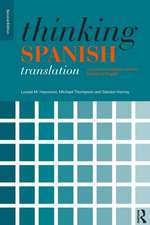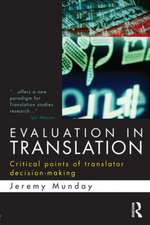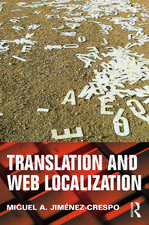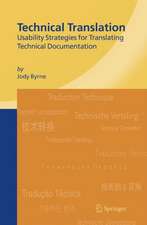Legal Translation Explained: Translation Practices Explained
Autor Enrique Alcaraz Editat de Anthony Pym Autor Brian Hughesen Limba Engleză Paperback – aug 2001
The numerous examples and discussions of specific terms make the book useful both as a manual in the translation class and as an invaluable reference work for students, teachers, self-learners and professional translators.
| Toate formatele și edițiile | Preț | Express |
|---|---|---|
| Paperback (1) | 289.61 lei 22-36 zile | +25.62 lei 5-11 zile |
| Taylor & Francis – aug 2001 | 289.61 lei 22-36 zile | +25.62 lei 5-11 zile |
| Hardback (1) | 1272.54 lei 43-57 zile | |
| Taylor & Francis – 29 sep 2015 | 1272.54 lei 43-57 zile |
Din seria Translation Practices Explained
-
 Preț: 303.87 lei
Preț: 303.87 lei -
 Preț: 302.16 lei
Preț: 302.16 lei -
 Preț: 265.72 lei
Preț: 265.72 lei -
 Preț: 233.92 lei
Preț: 233.92 lei -
 Preț: 280.81 lei
Preț: 280.81 lei -
 Preț: 288.80 lei
Preț: 288.80 lei -
 Preț: 309.50 lei
Preț: 309.50 lei -
 Preț: 228.76 lei
Preț: 228.76 lei -
 Preț: 346.94 lei
Preț: 346.94 lei - 18%
 Preț: 1058.65 lei
Preț: 1058.65 lei -
 Preț: 287.04 lei
Preț: 287.04 lei -
 Preț: 259.39 lei
Preț: 259.39 lei -
 Preț: 349.91 lei
Preț: 349.91 lei - 17%
 Preț: 271.43 lei
Preț: 271.43 lei -
 Preț: 279.69 lei
Preț: 279.69 lei -
 Preț: 465.91 lei
Preț: 465.91 lei - 5%
 Preț: 323.58 lei
Preț: 323.58 lei -
 Preț: 290.36 lei
Preț: 290.36 lei -
 Preț: 410.50 lei
Preț: 410.50 lei -
 Preț: 380.36 lei
Preț: 380.36 lei -
 Preț: 362.82 lei
Preț: 362.82 lei - 17%
 Preț: 246.74 lei
Preț: 246.74 lei - 17%
 Preț: 246.96 lei
Preț: 246.96 lei - 22%
 Preț: 371.87 lei
Preț: 371.87 lei -
 Preț: 443.69 lei
Preț: 443.69 lei - 13%
 Preț: 321.08 lei
Preț: 321.08 lei -
 Preț: 367.23 lei
Preț: 367.23 lei -
 Preț: 395.85 lei
Preț: 395.85 lei
Preț: 289.61 lei
Nou
Puncte Express: 434
Preț estimativ în valută:
55.42€ • 58.01$ • 45.85£
55.42€ • 58.01$ • 45.85£
Carte disponibilă
Livrare economică 17-31 martie
Livrare express 28 februarie-06 martie pentru 35.61 lei
Preluare comenzi: 021 569.72.76
Specificații
ISBN-13: 9781900650465
ISBN-10: 1900650460
Pagini: 216
Dimensiuni: 174 x 246 x 13 mm
Greutate: 0.53 kg
Ediția:1
Editura: Taylor & Francis
Colecția Routledge
Seria Translation Practices Explained
Locul publicării:Oxford, United Kingdom
ISBN-10: 1900650460
Pagini: 216
Dimensiuni: 174 x 246 x 13 mm
Greutate: 0.53 kg
Ediția:1
Editura: Taylor & Francis
Colecția Routledge
Seria Translation Practices Explained
Locul publicării:Oxford, United Kingdom
Public țintă
PostgraduateCuprins
Foreword
Acknowledgements
1. Some Pointers to the Linguistics of Legal English
1.1. Introduction: Legal English and the rise of English for professional purposes
1.2. The aims of the book
1.3. The leading features of legal English
1.4. 'Legalese' and 'The Plain English Campaign'
1.5. The classification of legal vocabulary
1.6. Some leading features of the morphology and syntax of legal English
2. Equivalence and Interpretation
2.1. The question of equivalence in translation studies
2.2. Judges and translators. Interpretation and construction. The elusiveness of meaning
2.3. Vagueness in legal lexical units (I). Definition. Extension and intension
2.4. Vagueness in legal lexical units (II). Denotation and connotation. Register
2.5. Vagueness in legal lexical units (III). Polysemy. The important of context
2.6. Vagueness in legal lexical units (IV). Homonymy
2.7. Vagueness in legal lexical units (V). Synonyms, hyperonyms and hyponyms
2.8. Vagueness in legal lexical units (VI). Antonyms
2.9. Vagueness in legal lexical units (VII). False cognates or 'false friends'
2.10. Figurative language: metaphors and buried metaphors
2.11. Syntactic ambiguity
3. Some Pointers to the English Legal System
3.1. Introduction. The translator and the legal background
3.2. The translator and the sources of English law
(a) Common Law
(b) Equity
(c) Statute law
3.3. The branches of English law. Jurisdiction and the court structure
3.4. The English Criminal Courts
3.5. The vocabulary of litigation
3.6. Common terms in litigation
3.7. The language of judges
3.8. The terms used in favourable judicial decisions
3.9. The terms used in unfavourable judicial decisions
4. Civil and Criminal Proceedings. Administrative Tribunals
4.1. Introduction
4.2. Civil proceedings
4.2.1 The new 'Civil procedure rules 1998'
4.2.2 The overriding objective
4.2.3 Unification of procedure
4.2.4 Allocation to track
4.3. Right of action: Some basic terms
4.4. Criminal proceedings
4.4.1 Arrest and charge
4.4.2 Types of offences
4.4.3 The trial
5. Administrative, Industrial and Domestic Tribunals
5. 1. Genres in the translation of legal English (I)
5.1.1. Introduction. Legal genres in translation
5.1.2. The macrostructure of legal genres. University degrees and diplomas
5.1.3. Certificates
5.1.4. Statutes
5.1.5. Law reports
5.1.6. Judgements
5.1.7. Oral genres (I). The examination of witnesses at the public hearing
5.1.8. Oral genres (II). Counsels' closing speeches to the jury, [jury summation]. Judge's summing-up and charge to the jury
6. Genres in the translation of legal English (II)
6.1. Contracts
6.2. Deeds and indentures
6.3. Insurance policies
6.4. Last will and testament
6.5. The power of attorney
6.6. The professional article
6.7. Legal English in popular fiction
7. Practical Problems in Translation Explained (I)
7.1. Translation as problem-solving
7.2. Legal vocabulary (I). The translation of purely technical vocabulary
7.2.1. Problems in the translation of one-word purely technical terms
7.2.2. Problems in the translation of multi-word purely technical terms
7.3. Legal vocabulary (II). The translation of semi-technical vocabulary
7.4. The translation of everyday vocabulary in legal English
7.5. The translation of functional vocabulary in legal English
7.6. Lexical resources in translation (l). The collocations of legal English
7.7. Lexical resources in translation (ll). The semantic fields of legal English
7.8. Lexical traps for the translator: false cognates and unconscious calques
8. Practical Problems in Translation Explained (II)
8.1. The translator at the crossroads: techniques of legal translation
8.2. Transposition
8.3. Expansion
8.4. Modulation
8.5. Modifiers
8.6. The syntax of legal English. Double conjunctions
8.7. Thematization. Syntactic peculiarities of individual languages
8.8. Textual coherence. Lexical repetition in English legal discourse. Synonyms
References
Index
Acknowledgements
1. Some Pointers to the Linguistics of Legal English
1.1. Introduction: Legal English and the rise of English for professional purposes
1.2. The aims of the book
1.3. The leading features of legal English
1.4. 'Legalese' and 'The Plain English Campaign'
1.5. The classification of legal vocabulary
1.6. Some leading features of the morphology and syntax of legal English
2. Equivalence and Interpretation
2.1. The question of equivalence in translation studies
2.2. Judges and translators. Interpretation and construction. The elusiveness of meaning
2.3. Vagueness in legal lexical units (I). Definition. Extension and intension
2.4. Vagueness in legal lexical units (II). Denotation and connotation. Register
2.5. Vagueness in legal lexical units (III). Polysemy. The important of context
2.6. Vagueness in legal lexical units (IV). Homonymy
2.7. Vagueness in legal lexical units (V). Synonyms, hyperonyms and hyponyms
2.8. Vagueness in legal lexical units (VI). Antonyms
2.9. Vagueness in legal lexical units (VII). False cognates or 'false friends'
2.10. Figurative language: metaphors and buried metaphors
2.11. Syntactic ambiguity
3. Some Pointers to the English Legal System
3.1. Introduction. The translator and the legal background
3.2. The translator and the sources of English law
(a) Common Law
(b) Equity
(c) Statute law
3.3. The branches of English law. Jurisdiction and the court structure
3.4. The English Criminal Courts
3.5. The vocabulary of litigation
3.6. Common terms in litigation
3.7. The language of judges
3.8. The terms used in favourable judicial decisions
3.9. The terms used in unfavourable judicial decisions
4. Civil and Criminal Proceedings. Administrative Tribunals
4.1. Introduction
4.2. Civil proceedings
4.2.1 The new 'Civil procedure rules 1998'
4.2.2 The overriding objective
4.2.3 Unification of procedure
4.2.4 Allocation to track
4.3. Right of action: Some basic terms
4.4. Criminal proceedings
4.4.1 Arrest and charge
4.4.2 Types of offences
4.4.3 The trial
5. Administrative, Industrial and Domestic Tribunals
5. 1. Genres in the translation of legal English (I)
5.1.1. Introduction. Legal genres in translation
5.1.2. The macrostructure of legal genres. University degrees and diplomas
5.1.3. Certificates
5.1.4. Statutes
5.1.5. Law reports
5.1.6. Judgements
5.1.7. Oral genres (I). The examination of witnesses at the public hearing
5.1.8. Oral genres (II). Counsels' closing speeches to the jury, [jury summation]. Judge's summing-up and charge to the jury
6. Genres in the translation of legal English (II)
6.1. Contracts
6.2. Deeds and indentures
6.3. Insurance policies
6.4. Last will and testament
6.5. The power of attorney
6.6. The professional article
6.7. Legal English in popular fiction
7. Practical Problems in Translation Explained (I)
7.1. Translation as problem-solving
7.2. Legal vocabulary (I). The translation of purely technical vocabulary
7.2.1. Problems in the translation of one-word purely technical terms
7.2.2. Problems in the translation of multi-word purely technical terms
7.3. Legal vocabulary (II). The translation of semi-technical vocabulary
7.4. The translation of everyday vocabulary in legal English
7.5. The translation of functional vocabulary in legal English
7.6. Lexical resources in translation (l). The collocations of legal English
7.7. Lexical resources in translation (ll). The semantic fields of legal English
7.8. Lexical traps for the translator: false cognates and unconscious calques
8. Practical Problems in Translation Explained (II)
8.1. The translator at the crossroads: techniques of legal translation
8.2. Transposition
8.3. Expansion
8.4. Modulation
8.5. Modifiers
8.6. The syntax of legal English. Double conjunctions
8.7. Thematization. Syntactic peculiarities of individual languages
8.8. Textual coherence. Lexical repetition in English legal discourse. Synonyms
References
Index
Notă biografică
Enrique Alcaraz and Brian Hughes
Descriere
Focusing on the problems of translating English legal language, Alcaraz and Hughes offer a wide-ranging view of one of the most demanding and vital areas of contemporary translation practice







